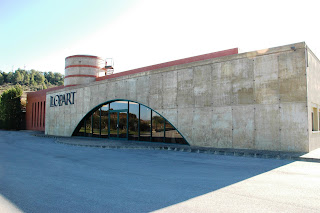As early as in the 14th century, records in Latin show that a Bernardus Leopardi owned vineyards in the present Llopart estate. Wheat and olives were grown there, too, until by end of 18th century the Llopart family focused on wine. One century later, they were among the first to start Cava production, but emphasizing quality over quantity. To this date, and after more than 600 years, this remarkably resilient family continues to do what must be engraved in their DNA, like the leopard’s spots.
The Llopart estate is located in the hilly countryside south of Sant Sadurní d’Anoia, the Cava capital, and within the boundaries of the village of Subirats. Its 60 hectares of vineyards have been divided into 3 sub zones according to microclimate and soil features. They have an average altitude of 340 m and enjoy, being protected from harsh North winds by the Montserrat massif, mild winters and sunny, not excessively hot summers. The vines receive an average 500 l / m2 of rain per year.
Soils are generally poor, a mixture in different proportions of sand and lime, with clay here and there. Farming methods are reportedly organic, although there is no official certification.
The main varieties used are the three classical for Cava, Parellada, Xarel.lo and Macabeu, plus Chardonnay, Monastrell, Pinot Noir, Subirat Parent, Garnatxa negra, Cabernet Sauvignon, Merlot and Ull de Llebre. Grapes are picked by hand and selected in the vineyard. Thus Llopart produce yearly ca. 450’000 bottles of eight Cavas and three still wines.
Still wines, under the DO Penedès label, are two whites, the Clos dels Fòssils (Chardonnay / Xarel.lo), and the Vitis (Xarel.lo, Subirat Parent / Muscat); and one red, the Castell de Subirats (Merlot / Ull de Llebre / Cabernet Sauvignon).
But the star in Llopart is Cava. Cava production follows, as it should, the traditional (aka Champenoise) method of second fermentation in bottle, closed with crown caps. Yeasts are local. Riddling is done manually, and degorjat mechanically (you may want to read my previous post about Cava production Is Cava a Catalan wine?). Degorjat date is not explicit, but the batch number is composed of the degorjat month and the last digit of the degorjat year. Most bottles show the vintage year.
Nèctar Terrenal Reserva is one of the few sweet (in fact a semi-dolç) quality Cavas available, made from 50/50 Xarel.lo and Parellada with 18 months of aging, and appropriate for dessert.
 Llopart Brut Nature Reserva is the workhorse of the firm: Macabeu, Xarel.lo, Parellada and Chardonnay 30/40/20/10, and 26 months of bottle give a fine, elegant and versatile Cava.
Llopart Brut Nature Reserva is the workhorse of the firm: Macabeu, Xarel.lo, Parellada and Chardonnay 30/40/20/10, and 26 months of bottle give a fine, elegant and versatile Cava.Rosé Cava is on the rise, and Llopart offer two different examples: Llopart Rosé Brut Reserva, from Monastrell, Garnatxa negra and Pinot Noir 60/20/20, and 18 months in bottle; and Microcosmos Brut Nature Reserva: Pinot Noir and Monastrell 85/15 kept for 24 months in bottle.
The Llopart Integral Brut Nature is the lightest of the range. Parellada, Chardonnay and Xarel.lo 40/40/20 and 18 months of aging render a lively, flowery Cava most suited to be drunk by itself or with light tapas.
Last but not least, three Gran Reservas complete the choice. Their long ageing shows in the tertiary aromas of bread and toast, and creamy feel. They are fit for pairing with a full meal, however strong it may be.
Llopart Imperial Brut Gran Reserva comes from Macabeu, Xarel.lo and Parellada, 40/50/10, and 15 % of the base wine has been aged in oak. 42 months aging in bottle.
 Leopardi Brut Nature Gran Reserva has Macabeu, Xarel.lo. Parellada and Chardonnay 40/40/10/10, with 48 months in bottle.
Leopardi Brut Nature Gran Reserva has Macabeu, Xarel.lo. Parellada and Chardonnay 40/40/10/10, with 48 months in bottle.Ex vite (from “Ex vite vita”, Latin for “Life comes from the vine”) Brut Gran Reserva is the top wine of the house, coming from old Macabeu and Xarel.lo vines (40/60) carefully selected fruit. Base wine partly aged in oak and wild yeast selection. Expedition liquor based on 19th century recipe. All this to produce 5’300 bottles that age for over 60 months to yield a golden wine with small, slow bubble, complex nose and long finish.
What will the Lloparts be doing in 600 years’ time? Guess my bet?






No comments:
Post a Comment